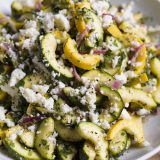Lunch at El Naranjo, an Oaxacan eatery run by Iliana de la Vega in Austin, Texas, for me was a game-changing introduction to a regional Mexican cuisine.
The first course was a quesadilla de hoja santa, a large green leaf covering a filling of lightly salty, chewy Oaxacan cheese (a pulled cheese much like mozzarella) covered with salsa verde. The main dish was enchiladas filled with duck and sauced with a chocolate mole that was complex and slightly sweet; it had a tropical fruitiness from chilies along with a foundation of subtle heat and hints of cinnamon, cloves and cumin.
This is food replete with sophistication and culinary surprises, just the thing for a Milk Street traveler.
A master of Oaxacan cooking, de la Vega ran El Naranjo in Oaxaca for many years in a refurbished colonial house complete with courtyard. She left in 2006 and set up shop in Austin, where her food is every bit as good as what one finds in her hometown.
After lunch, we chatted about the nature of Oaxacan cooking, a short course in how to rethink the culinary arts. She explained that a mole has three components: vegetables (tomatoes, tomatillos, chilies, etc.), spices, and a thickener (nuts, masa, etc.). She also pointed out that dry roasting is a pre-Columbian technique (as in roasting vegetables on a comal), whereas frying is post-Spanish.
Other Oaxacan culinary tips include combining spicy or sweet with bitter (chocolate is added to a mole only to balance the bitterness; it’s less about the chocolate itself) and that one cooks with the chilies available, each one having a different flavor profile. In Oaxaca, chilies are vegetables.
What is refreshing about de la Vega’s cuisine is that it is not limited to the usual suspects: tlayudas, molletes, tacos, moles and the like. The food is fresh, offering ingredient pairings that make one sit up straight and take notice.
One of my favorite El Naranjo dishes is a summer squash salad. Slices of red onion are pickled quickly in vinegar. Zucchini and yellow squash are microwaved until crisp-tender, then fresh cilantro and oregano are added with a crumble of queso fresco (or chèvre) to finish. The mild bite of pickled onion is married to fresh vegetables and herbs with a sprinkling of creamy cheese. This is the cooking of Oaxaca and de la Vega—simplicity matched with surprising bedfellows, the perfect cuisine for the new world.




